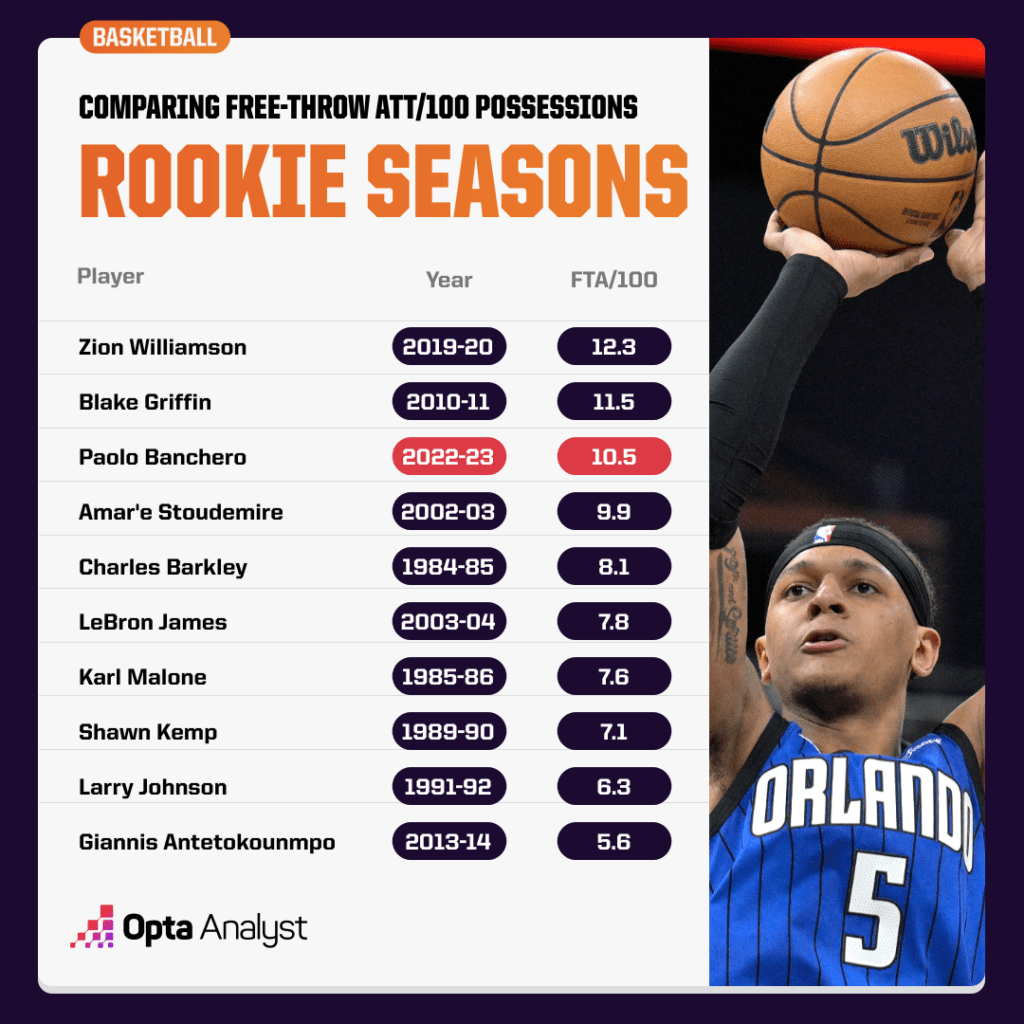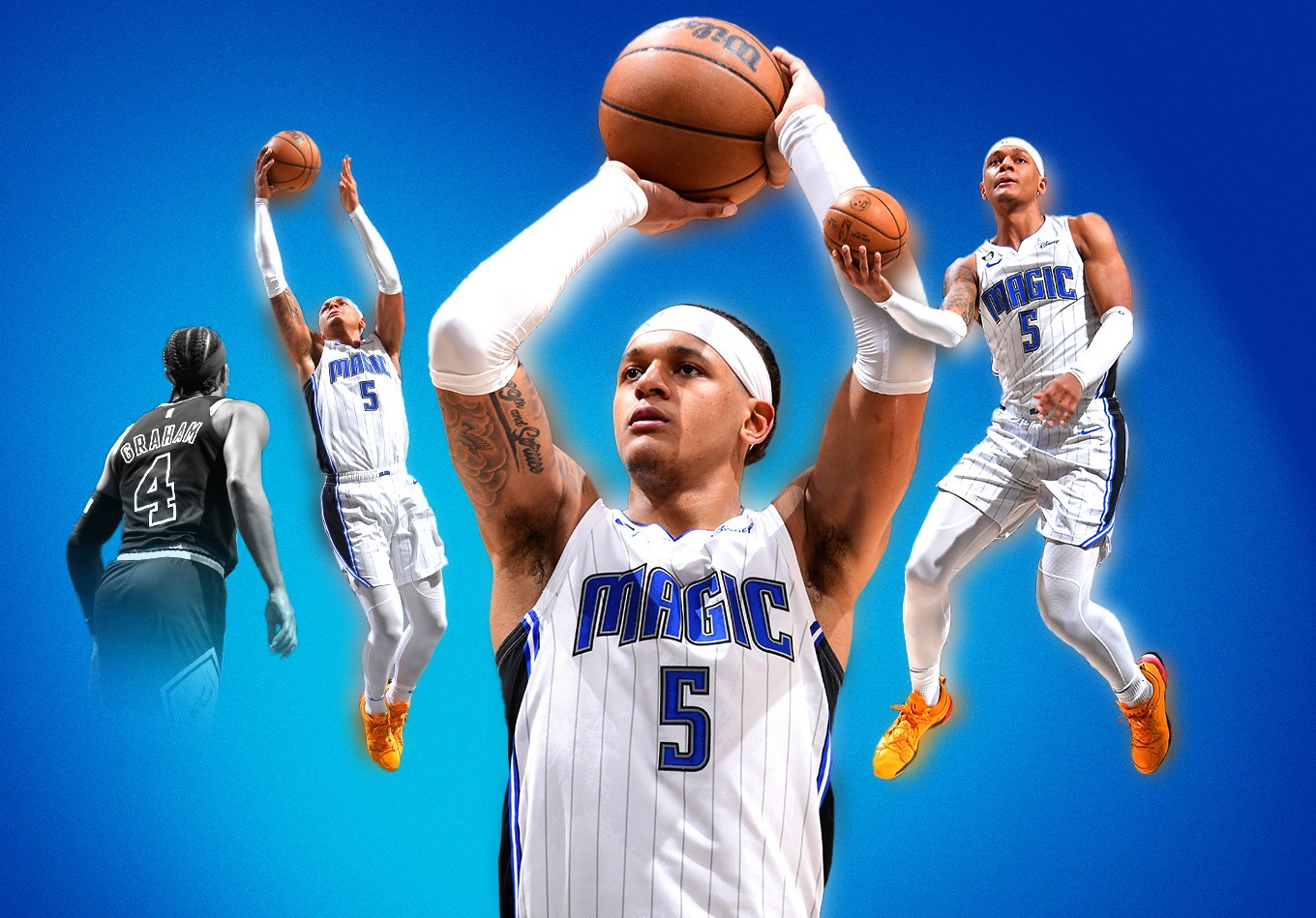The only times before 2022 that the Orlando Magic selected No. 1 in the NBA Draft, they chose three players who went on to become Hall-of-Fame caliber big men (Shaquille O’Neal, Chris Webber and Dwight Howard).
No matter how much you try to temper expectations, finding a superstar you can build around is often a franchise’s goal when it is gifted the first overall pick. That’s the case even in a supposedly (at least, according to the consensus narrative) weak year like the class of 2022.
So naturally, when the Magic used their fourth first-overall pick in franchise history to select Duke forward Paolo Banchero, the expectation was that he’d be the one to resurrect the downtrodden organization.
And while it is impossible to pass final judgment on a prospect after his rookie season (just ask Peyton Manning), we do have enough data to begin to answer the question.
And for those still wondering, that question is as follows: Can Banchero someday develop into an MVP-level player?
The Good
Don’t let his 52.8 true shooting percentage (10th percentile) and 54.4% shooting at the rim (27th percentile) fool you, Banchero is a basketball bulldozer, capable of making his way into the paint whenever he pleases.
He may not be old enough to drink, but he’s undoubtedly built better than any regular at your local dive bar. Like Charles Barkley once upon a time, he leverages his robust frame by lowering his lead shoulder and ramming himself into the defender’s chest. This technique throws his adversary off balance and clears up the lane like a human pinsetter.
The way he’s able to consistently carve out space with his shoulder is a testament to his ability to achieve a lower center of gravity than his opponent. In football, you’re taught that the lower player (whether that be the defender or offensive player) is often the one who emerges from the contact victorious.
Well, the same is typically true with driving in basketball. The lower you can get with the ball, the easier it is for you to maintain control and power (or weave) your way through traffic.
Where his bully-ball skills are a callback to Sir Charles, his transition game bears resemblance to current NBA superstar Giannis Antetokounmpo.
While not nearly as nimble or agile, Banchero’s grab-and-go sequences have a gazelle-like quality to them. His early offense escapades aren’t yet all that efficient (33rd percentile, per NBA.com). But he’s already able to produce these types of possessions at an elite rate (95th percentile in transition possessions per game). This ensures his employer a high volume of one of the most efficient play types for the duration of his prime.
Banchero’s overall on-ball explosiveness makes him a nearly unstoppable force when he’s barrelling toward the rim. So inevitable, in fact, that defenses typically have to resort to fouling to steer him off his course.
His 10.6 free throw attempts per 100 possessions put him in the 96th percentile in the league. That foul-drawing rate is ridiculously high for a rookie, even when you compare it to the inaugural seasons of other great downhill-driving forwards:

OK, so Banchero is great at getting to the rim and the free-throw line. Why is he so inefficient then?
There’s a handful of reasons. First, he’s a rookie, and rookies are almost always inefficient (believe it or not, there’s a bit of a learning curve when it comes to adjusting to finishing over giants all the time).
Second, he’s often entering a highly congested paint. The Magic are 27th in 3-pointers made, 27th in 3-point attempts and 23rd in 3-point percentage. Orlando doesn’t have a ton of shooters, and its opponents know it. As a result, the Magic opt to help off of players in an effort to pack the interior.
And third, Orlando doesn’t have a strong on-ball creator that can set up Banchero with high-percentage looks. Only 40.9% of his 2-pointers have been assisted this season.
Banchero, like Antetokounmpo, is best utilized in a play-finisher role where he can use his immense physical gifts to profit off of rim rolls, cuts, and quick post-ups. Look for his efficiency to skyrocket when he’s paired with his own version of Jrue Holiday.
That’s not to say Banchero shouldn’t ever be on the ball. In fact, his ball skills are quite advanced given his size and age. Like Barkley and Antetokounmpo, Banchero can already make solid kick-out reads when he brings a second defender in his airspace (first play in the montage below). And every once in a while, he’ll even surprise you with a slingshot layup pass (second play).
However, for every strike he throws, it seems he follows it with a wild pitch. The percentage of Orlando turnovers Banchero commits while he’s on the court (25.6%) is the third highest of all rookies that have played at least 25 games (trailing only Jaden Ivey and Blake Wesley).
Again, at least part of this is due to the storm of bodies he’s constantly seeing because of his team’s poor spacing.
The Bad
When we mentioned the reasons for Banchero’s lower-tier efficiency, we intentionally omitted one factor to include it in this section. To put it plainly, Banchero is not a good jump shooter right now. And it’s especially damaging when you consider the high volume of pull-up shots he takes.
Among the 56 players that take at least five pull-up jumpers per game, Banchero ranks second-to-last in effective field goal percentage (a stat that adjusts for the fact that 3s are worth more than 2s).
That not only kills his efficiency and compounds the Magic’s spacing dilemma, but it also serves to mitigate the value of his interior scoring, as defenses will regularly sag off him to prevent a drive and dare him to beat them with his jumper.
The good news here is that Banchero’s college 3-point percentage (33.8%) and free-throw conversation rate (72.9%) paint the picture of a slightly better shooter than he is now and indicate that he’s further along in that path than either Barkley or Antetokounmpo was at his age. According to AutoStats player tracking data, 51.0% of Banchero’s 3-point attempts at Duke were contested. He shot 43.0% on uncontested 3-pointers but only 17.0% on contested 3s.
And his average influence score, which measures how tightly a player is covered, ranked in the 91st percentage of college basketball on his jumpers last year.
The real concerns for Banchero lie on the defensive side of the ball. He’s built like a classic 90s power forward, and that’s awesome for all the reasons we’ve outlined, but it also gives him a certain level of stiffness that is damaging in the space ball era he currently occupies.
His limitations on that end are evident when you compare his on-ball defense to that of Oklahoma City Thunder rookie Jalen Williams. While they play different positions, the differences in their lower bodies are telling. Banchero is stationary, with his heels planted firmly on the hardwood. Meanwhile, Williams is constantly moving on the balls of his feet, ready to mime his defender at a moment’s notice.
This same inactivity/awkwardness can also show up at times with his off-ball defense and rim protection. He also seems to be pretty ground-bound on defense, which limits his rim-protecting ability.
Overall, his minus-1.4 defensive DRIP (our catch-all metric, which projects a player’s contribution to a team’s plus-minus per 100 possessions) is in the 15th percentile among players with at least 700 minutes played this season.
Of course, there is some room for optimism. Along with being inefficient, rookies are typically poor defenders (man, it really sucks being a rookie).
Plus, he’s shown some resiliency against favorable matchups (he had some nice moments defending Jayson Tatum and Jaylen Brown back in December). And he’s also flashed good defensive instincts (like knowing to swipe down at the ball instead of trying to challenge Joel Embiid vertically or rotating over early to deter Brook Lopez’s drive to the rim).
Thanks to his size and burgeoning defensive instincts, Banchero has a chance to become a positive defender. But because of his physical limitations, you’ll want to surround him with a sound defensive infrastructure and a center that can anchor the interior.
The Outlook
The one player comparison we have yet to mention is the one he was most frequently tied to during the pre-draft process: Julius Randle.
When you think about it, Banchero’s player profile – a physical force with advanced ball skills for his size, a shaky jumper, and spotty defense – looks eerily similar to Randle’s current makeup.
And if Banchero ultimately develops into his generation’s Julius Randle, he becomes a fringe All-Star during his best seasons – a noteworthy accomplishment indeed.
But if Banchero wants to become something more, something like the other greats that Orlando drafted first overall, he’ll need to clean up his efficiency, level up his passing and ball handling, develop a serviceable jumper, and become a positive defender for his position.
So, which one of those paths will Banchero go down?
Ultimately, the answer, like most things in life, lies somewhere in the middle. He likely won’t have the MVP peak of Barkley and Antetokounmpo (hardly anyone ever has or will).
But he’s already a more dominant physical specimen than Randle, and he’s not too far behind as a playmaker, either. And it’s because of this, and the room for growth afforded to him by his rookie status, that Banchero has a real shot of being a perennial All-NBA forward.
